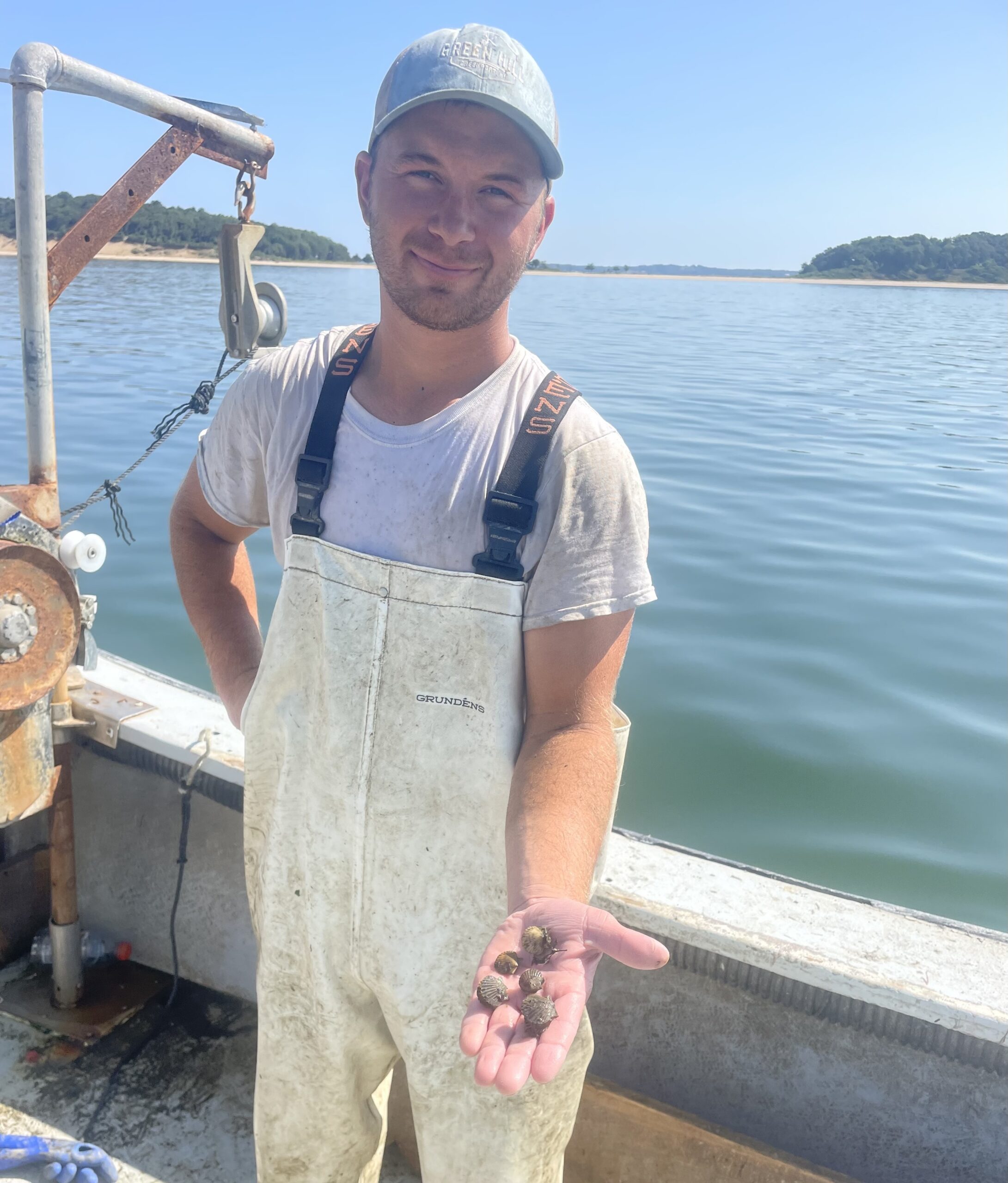
The doomsday scenario that many had feared would eventually beset Peconic bay scallops amid a succession of massive die-offs appears to have finally occurred, according to scientists who found evidence of poor spawning “recruitment” this summer, followed by the deaths of most of the wild scallop stock.
Surveys of two dozen sites around the Peconic Estuary by scientists from Cornell Cooperative Extension have once again revealed what appears to be an almost total die-off of adult bay scallops ahead of the opening of the annual harvest next Monday, November 7.
But while in the previous three seasons the adult scallops spawned and produced giant “sets” of offspring, this year’s scallops do not appear to have reproduced as prodigiously.
“In total, over what is a couple miles of surveyed bottom, in all, we found 19 adult scallops total — so that’s not a good sign for the harvest this fall,” said Harrison Tobi, an aquaculture specialist for Cornell who heads up the annual scallop surveys.
“And what’s more concerning is that juvenile numbers this year are much lower than what we’ve seen in the last few years. Last year, we found hundreds [in Orient Harbor], over 300. This year, we only found about 30. Which means that the brood stock next year is going to be even lower, which is very concerning for recruitment. So, it’s not only looking pretty grim for this fall, it’s also very foreboding for 2023.”
Across 22 locations scattered from Flanders Bay to Orient, the Cornell scientists have surveyed 50-foot-by-1-foot transacts of bay bottoms each fall to track the relative abundance of scallops. In each of the last four years, they have found die-offs of upward of 95 percent of the adult scallops in the Peconic.
Following the first widespread die-off in 2019 — which had followed one of the largest harvests in decades and hopes that the bay scallop population was finally rebounding from the devastation of the “brown tides” in the 1980s and 1990s — a broad scientific effort to identify the cause determined that a combination of chronically high water temperatures, a newly discovered parasite and other environmental factors, like predators, and even the biological stress of the act of spawning had combined to wipe out adult scallops.
Perhaps the lone bright spot in the wake of the die-offs that year and again in 2020 and 2021 was the discovery that before they had died, the adult scallops had produced huge numbers of baby scallops, called “bugs.” In 2021, the set, as the population of young-of-the-year scallops are called, was the one of the largest the scientists who have been working since 2005 to rebuild the wild stock had ever recorded.
But the biologists and fishermen who watched anxiously as the deadly cycle repeated itself had barely dared to speak out loud the obvious worry that, eventually, the scallops would have a poor spawning year for other natural reasons likely unrelated to the die-offs.
Without a large population of adults to spawn, the wild stock of scallops could quickly collapse if the annual summer die-offs of adults continue.
“Scallops can produce millions of eggs, but with natural populations being very low, adults might have a hard time finding one another to spawn and those eggs might not get fertilized,” said Stephen Tettelbach, Ph.D., one of the shellfish ecologists who started the Bay Scallop Restoration Program in 2005. “There might be some survival, but the population will remain at low, very low, levels. We could get back to where we were before we started the program. There will not be a viable fishery.”
Before 2019, scientists thought they had finally helped the wild bay scallop stock rebuild to a point it could again sustain and expand itself naturally.
When the Bay Scallop Restoration Program was begun in 2005, the harvest of Peconic bay scallops was just 3,000 pounds, less than 1 percent of the historical annual average in the years prior to the first outbreak of the brown tide algae blooms in 1985. By 2018, landings had increased more than 30-fold, approaching 100,000 pounds for the first time since 1994.
The restoration program had relied on spawning bay scallops in a hatchery in Southold, growing them in protective enclosures to a size that they could better survive the rigors of life on the bay bottoms and then releasing — or seeding — hundreds of thousands of them in local harbors and bays. Hundreds of thousands more were kept in nets in Orient Harbor, where they spawned as if part of a dense wild population and their offspring released into the currents to set in the wild.
Tettlebach acknowledged that the rebuilding effort could be back to square one, but also that it could, potentially, start over with a new rebuilding.
Scientists from Stony Brook University are already experimenting with selective breeding at the hatcheries, taking individual scallops that have survived the recent die-offs and using them to spawn the hatchery stock in the hope that certain scallops may have genetic traits that help them better weather warmer waters or make them less vulnerable to the new parasite.
“Theoretically, it can be done,” Tettelbach said. “I think our best hope is developing strains that are more resilient. We don’t know that that is going to happen though.”
The Bay Scallop Restoration Program is funded by Suffolk County, but in steadily declining levels, and there is concern that an advisory committee that oversees the water quality grants the program relies on is becoming less dedicated to the cause. Tettelbach said that the looming disaster for scallops this year will hopefully spur a renewal of the grant funding.
“If we don’t get funding, we’re dead in the water and there’s nobody else to pick up what we do,” he said. “The reason for the resurgence of scallops in the first place was because of what we did. If the natural stock is going back down, we desperately need to continue that work.”